Best Practices for IT Infrastructure Management in 2024
At Easy2Patch, we believe managing your IT infrastructure is both challenging and necessary. That’s why we are here to help you navigate the complexities of your IT infrastructure.
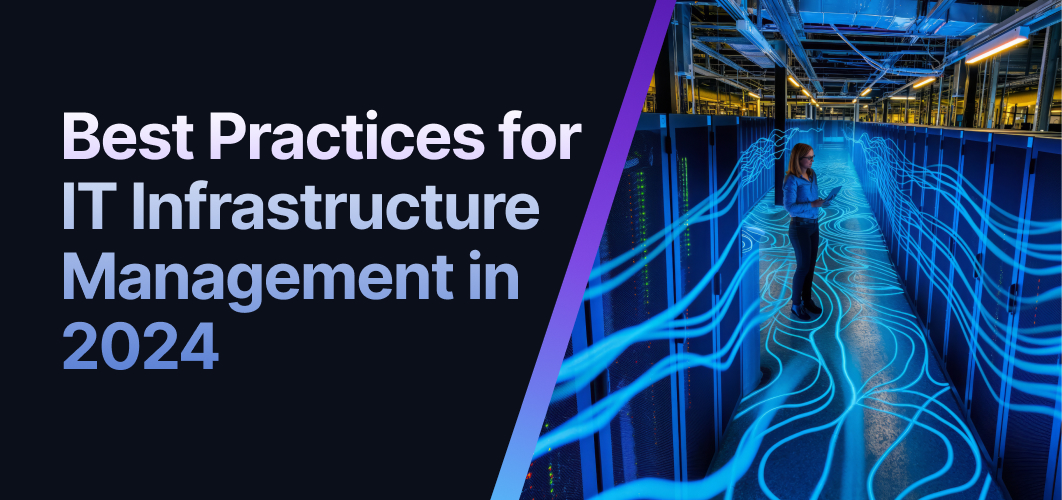
Effective IT infrastructure management ensures your systems are secure, reliable, and efficient. Many small and medium-sized business leaders underestimate their IT needs. They think they are less complex than those of larger organizations. However, this is a misconception: every business, regardless of size, requires a mighty IT infrastructure to thrive.
After reading this article, you'll be empowered with the knowledge you need to make informed decisions and stay updated on 2024 best practices for managing your IT infrastructure.
First things first! Understanding IT infrastructure management helps set the stage for implementing effective strategies and solutions. Let's start by exploring this topic, then we'll move on to discussing best practices and real-world examples.
IT Infrastructure Management Definition and Role in Business Operations
Simply put, IT infrastructure management ensures all those technology components keep running smoothly. But what exactly is it, and what does it involve? Let's break it down.
IT infrastructure management is basically the backbone of a business's IT setup. It covers everything from the servers, computers, routers, and storage systems to the software side, including operating systems, applications, and management tools. Then there's data storage, which keeps information safe and accessible. And of course, cloud services are offering flexible IT resources.
Why is IT infrastructure management so crucial for businesses?
- Efficiency: When hardware and software are in sync, operations run like clockwork. And if there's a hiccup, a solid incident management plan keeps things on track.
- Security: Keeping data safe is a top priority today. A well-managed and strong IT infrastructure keeps cyber threats at bay and ensures sensitive information stays safe.
- Business Agility and Competitive Advantage: Every business wants to stay ahead of the competition. Agility is one of the main keys! With flexible IT infrastructure, businesses can adapt quickly to changing market conditions, deploy new services, scale up operations, and make informed decisions based on real-time data.
- Innovation and Cloud Technologies: You must have heard of cloud computing. Cloud services facilitate agility, cost-effectiveness, and scalability without significant upfront investments in physical hardware. They are the cornerstone of modern IT infrastructure management and fuel innovation by providing access to cutting-edge technologies such as AI, machine learning, and IoT.
Now, it is time to ask ourselves: How do we ensure smooth IT infrastructure management? This question leads us to the exploration of Best Practices for Managing IT Infrastructure.
Best Practices for Managing IT Infrastructure in 2024
Best practices in this section function as the framework, ensuring smooth operations and mitigating risks. They optimize performance, streamline operations, and enhance cybersecurity measures. They are fundamental for maintaining business continuity and fostering innovation. Let’s explore them:
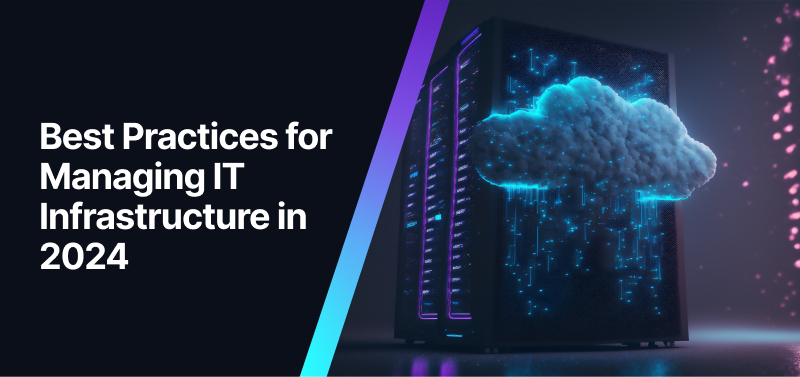
- IT Infrastructure Project Management: Optimizing IT infrastructure means upgrading hardware or software systems or changing servers. It requires a solid understanding of IT systems, their scalability, compatibility with other technology, and how to monitor, recycle, or decommission certain components.
- Proactive Maintenance: Who has time for downtime? Shift your focus to preventing problems and minimizing downtime. This approach to proactive maintenance keeps your IT infrastructure healthy.
- Root Cause Analysis: Application failures cause chaos. Conducting a thorough root cause analysis reduces application failure-related downtime. Identifying the root cause of problems helps in addressing them effectively and minimizing future occurrences.
- Understanding OS Stacks: Ask yourself, 'What's my strategy for staying current with OS Stacks? Try to stay updated with the latest OS patches, versions, and release upgrades. Keep your systems secure and stable with a planned schedule.
- Comprehensive IT Infrastructure Management Plan: If you want all your IT systems to run smoothly, develop a comprehensive plan. This plan should outline strategies for maintenance, security, scalability, and disaster recovery.
- Monitor Performance Metrics: Catch problems before they escalate. Regularly monitor performance metrics to identify potential issues before they get to a critical point. This proactive approach helps in maintaining optimal performance and avoiding downtime.
- Implement Robust Security Measures: In fact, we always have to be concerned about cyber threats. Security is a critical aspect of IT infrastructure management. Implement strong security measures to protect against cyber threats and ensure the confidentiality, integrity, and availability of data.
- Adopt a Disaster Recovery Plan: What's your plan if disaster strikes? Develop and implement a disaster recovery plan to ensure business continuity in case of any unforeseen events. Regularly test and update the plan to adapt to changing business needs and technological advancements.
- Implement a Scalable Infrastructure: Is your IT infrastructure ready to grow with your business? Build an IT infrastructure that is scalable and can grow with your business. Scalability accommodates increasing demands without major disruptions.
- Use Automation and Self-Service Tools: How can you work smarter, not harder? Leverage automation and self-service tools to improve efficiency and reduce manual errors. Automation streamlines routine tasks, freeing up resources for more strategic initiatives. Easy2Patch is your go-to for hassle-free third-party patch management, automating updates and boosting productivity.
- Prioritize Performance and Availability: Regularly evaluate the performance and availability of the existing infrastructure. Identify areas for improvement and implement measures to enhance performance and ensure high availability.
- Implement Effective Monitoring: How can you stay at least one step ahead of potential issues? Implement effective monitoring tools and processes to identify and resolve issues proactively. Monitoring allows IT teams to detect problems early and take corrective action before they impact operations.
- Choose Your Partners Wisely: If you want to build a rock-solid IT environment, collaborate with the right technology partners. Choose partners who can provide expertise, support, and solutions that align with your business objectives and IT requirements.
Real-World Examples of Successful IT Infrastructure Management
Maintaining a robust and scalable IT infrastructure allows the company to deliver high-quality solutions and support to its global client base. These examples highlight the importance of IT infrastructure management in ensuring business success:
Walmart: Scalable and Flexible IT Architecture
Walmart built an IT infrastructure that supports its extensive global operations. Key aspects include:
- Scalability: Walmart's IT system handles large amounts of data from stores worldwide. It ensures smooth operations during peak periods like Black Friday.
- Flexibility: The infrastructure adapts quickly to new technologies and business models. Consequently, Walmart integrates new services and responds to market changes efficiently.
Walmart's robust IT framework keeps its operations seamless and enhances customer shopping experiences.
Delta Airlines: Enhancing Customer Experience through IT Investments
Delta Airlines invested heavily in IT infrastructure to improve customer experience and operational efficiency. Key initiatives include:
- Customer Experience: Delta's advanced IT systems offer real-time updates, streamline check-in processes, and provide personalized services.
- Operational Efficiency: The airline uses data analytics and automation tools to optimize flight operations, manage logistics, and improve maintenance schedules.
These IT investments have enhanced the travel experience and improved Delta's operational performance.
Urban Aboriginal Agency: Digital Transformation for Remote Services
The Urban Aboriginal Agency faced significant IT challenges at the start of the COVID-19 pandemic. Issues included network bottlenecks, Wi-Fi interruptions, and unreliable landlines. The agency's response included:
- Network Upgrades: Invest in better networking solutions and network management tools to eliminate bottlenecks and ensure reliable connectivity.
- Modernization: Updating core IT infrastructure to support remote work and virtual service delivery.
- Digital Transformation: Implementing new digital tools and platforms to enhance the virtualization of social services.
These changes enabled the agency to continue providing essential services during lockdowns and beyond.
South Florida-based Client: Streamlining Laboratory Information Management
A South Florida-based client offers a Laboratory Information Management System (LIMS) solution used by over 1,100 organizations in 60 countries. The company's IT infrastructure management involved:
- Expansion and Scalability: Developing an IT infrastructure that supports growth from a small team to 300 employees and 17 offices worldwide.
- Quality and Safety: Ensuring IT systems enhance product quality and safety throughout the product life cycle.
- Post-Acquisition Integration: Following its acquisition by a global private equity firm, the company integrated its IT systems with new technologies and business processes.
Check more Real-World time examples.
Experts' Advice on IT Infrastructure Management
Fondateur | Dirigeant d’entreprise
“To effectively manage IT infrastructure, conduct a thorough audit including hardware, software, and data flow analysis, and use tools like CMDB for mapping. Integrate IT management with ITSM, governance, security, and projects, utilizing frameworks like ITIL and platforms such as ServiceNow for holistic oversight. Embrace orchestration and automation with tools like Ansible and Kubernetes to standardize and enhance efficiency. Leverage data analytics and AI for proactive insights and AIOps for problem prediction. Ensure security is embedded from the start, supported by tools for compliance and risk management. Prioritize change and capacity management to adapt to evolving needs, employing dynamic scaling for resource optimization.”
Strategic Thinker & Innovator | Servant-Leader | Keynote Speaker | American Dream
“I never can over emphasize automation and standardization to simplify complex IT environments. One of the reasons why clouds have been so successful is that they are highly standardized and automated. You can learn lots of lessons from cloud when it comes to creating on-premise or other IT/OT infrastructures. Simplicity is profound.”
Architecture Services Lead at Utilicast, Cleanie Gold Award Winner 2021
“Because the technology is changing so rapidly it is becoming very important to define your logical architecture and map this to the physical. This is because the physical architecture that realizes the logic is changing much more rapidly. With the rise of AI I do not believe we understand the future "how" as well as we used to. However the "what" of the business is often clearer and by clearly separating the two and logically correcting them we are in a better position to move forward.”
Conclusion
In wrapping up, it's clear that managing your IT setup in 2024 is crucial for ensuring your business runs smoothly. Understanding the ins and outs of IT management helps keep your systems secure, efficient, and reliable.
Some of the most recent best practices in IT infrastructure management for 2024 are key steps to optimize your IT systems. These include:
- IT Infrastructure Project Management
- Proactive Maintenance
- Root Cause Analysis
- Understanding OS Stacks
- Monitor Performance Metrics
- Implement Robust Security Measures
- Adopt a Disaster Recovery Plan
- Implement a Scalable Infrastructure
- Use Automation and Self-Service Tools
- Prioritize Performance and Availability
- Implement Effective Monitoring
- Choose Your Partners Wisely
Real-world examples, such as Walmart's scalable IT architecture, highlight how effective IT management can drive operational efficiency, enhance customer experiences, and ensure business continuity. To enhance your IT infrastructure, we suggest considering our third-party patch management solution. At Easy2Patch, we're here to help you keep your systems secure and up-to-date.
Frequently Asked Questions
Common performance issues include:
- Inefficient data management
- Budget constraints for technical innovation
- Cyber threats
- Lack of powerful computing platforms
- Frequent upgrades,
- Ineffective cost management,
- Unsecured endpoints
- Insufficient data storage
Security measures include strong access controls, regular software and hardware updates, security audits, and risk assessments. Encrypting sensitive data, using firewalls and intrusion detection systems, and employee education are also essential. Additional measures include URL filtering, anti-virus tools, sandboxing, secure email gateways, and endpoint detection and response (EDR) tools.
- Protect your team’s time and involve them in project planning.
- Understand the importance of IT infrastructure planning.
- Forecast future resource requirements based on business needs and growth projections.
- Use resource management software.
- Conduct IT inventory audits.
- Monitor depreciation rates and maintenance needs.
- Establish SOPs for consistent processes
- Maintain proper security efforts.
ITIL (Information Technology Infrastructure Library) change management includes a risk assessment process to identify and evaluate potential risks associated with changes. This process helps organizations determine the likelihood and impact of potential risks and take appropriate actions to mitigate or control those risks.
Key elements include:
- Risk assessment and management
- Clear organizational roles and responsibilities
- Prioritization of business functions
- An effective communication strategy
- Backup management
Some of the best practices for maintaining a comprehensive inventory of all IT assets within the organization include:
- Maintain up-to-date inventory management of all current and obsolete assets.
- Manage assets from purchase until disposal.
- Ensure IT security compliance with license, regulatory, and policies to reduce the risk of fines for non-compliance.
Major components include:
- Hardware platforms
- Enterprise and software platforms
- Operating system platforms
- Data storage management
- Network and telecommunication platforms
- Internet platforms
- Customer and system integration services.
To manage these individual components, it’s important to adopt strategies that enhance the overall efficiency of your IT infrastructure. These include:
- Hardware:
- Regularly maintain and update.
- Replace when obsolete.
- Software:
- Regularly update and patch.
- Track usage and licenses with management tools.
- Networks:
- Monitor for performance issues.
- Implement firewalls and intrusion detection systems.
- Data Centers:
- Optimize energy usage.
- Maintain physical security.
- Regularly back up data.
- Cloud Services:
- Choose the right service level agreements (SLAs).
- Monitor usage to avoid cost overruns.
- Ensure data security.
- Security System:
- Implement strong access controls.
- Regularly update security software and hardware.
- Conduct security audits and risk assessments.
- Encrypt sensitive data.
- Educate employees.
- IT Service Management (ITSM):
- Use frameworks like ITIL or COBIT for best practices.
IT Automation Key Benefits and Best Practices

What Is Vulnerability Management?

Ultimate IT Risk Management Guide 2024: Best Practices, Strategies, and Tools
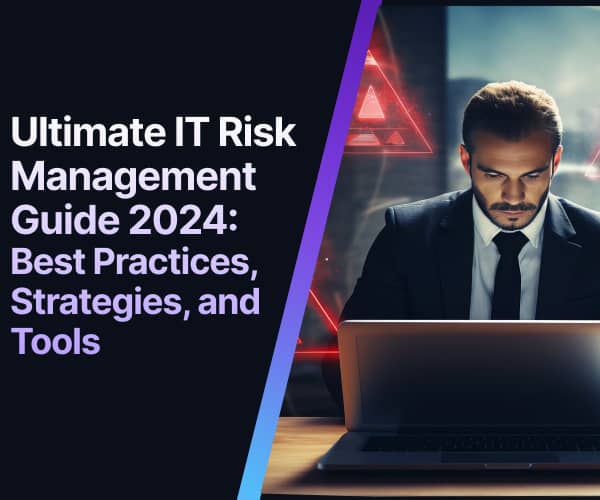
Best Practices for IT Infrastructure Management in 2024
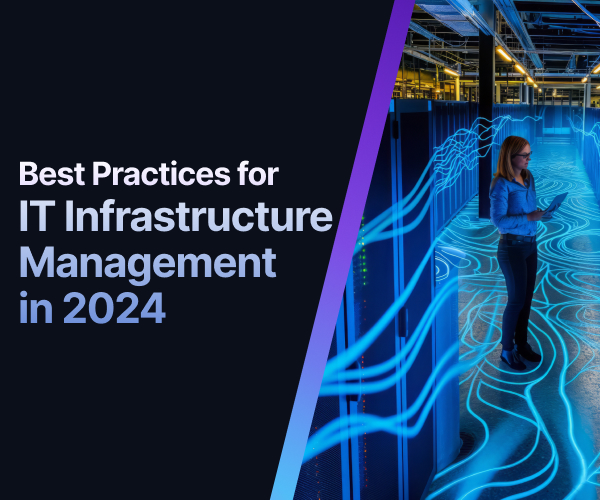
What is Windows Patch Management? Features, Challenges, and Best Practices in 2024
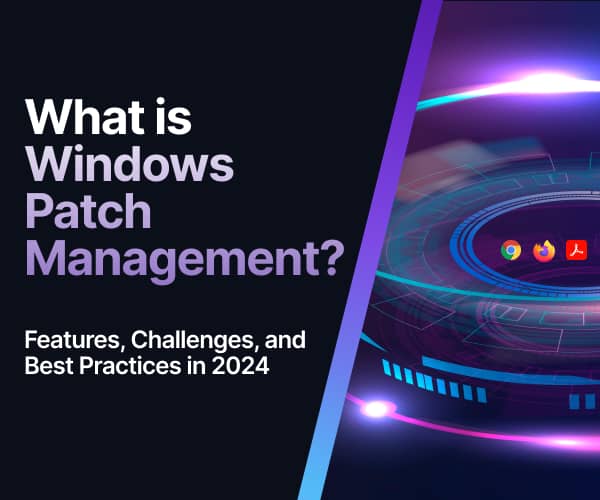
What are the Cybersecurity Risks Associated with Outdated Software and Operating Systems?





